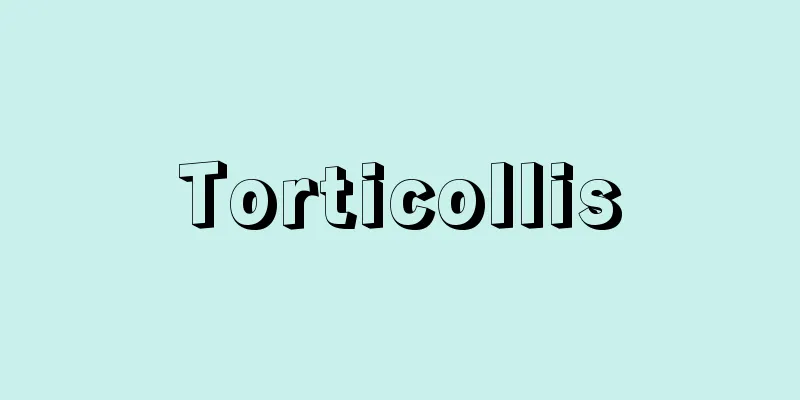Torticollis

|
This refers to a condition in which the neck is bent to the side, and can occur for a variety of reasons, but can be broadly divided into congenital and acquired. Congenital muscular torticollis is a typical example, and is a disease of the sternocleidomastoid muscle (the strongest muscle in the neck that runs from the sternum and clavicle to the mastoid process behind the ear). The cause is unclear, but a mass is present at the branch of the sternocleidomastoid muscle on one side of the newborn, which grows until about 3 to 4 weeks after birth, causing the baby to assume a torticollis position. After that, the mass gradually shrinks, and the torticollis often heals naturally within one year of birth. In the past, manual massage was used as a treatment during this period, but in recent years it has been discontinued as it is considered to be harmful. It is necessary to correct the torticollis position as much as possible and keep the patient lying down to prevent the development of cranial and facial asymmetry. In some cases that do not heal naturally, the sternocleidomastoid muscle shortens and becomes tense, causing the torticollis position to become severe, so open surgery is required around 1 to 2 years after birth. If surgery is not performed, as the baby grows, not only the torticollis but also the cranial and facial deformations will become more severe. In addition, congenital bony torticollis is caused by wedge vertebrae in the cervical vertebrae. An acquired form of torticollis is lymphatic torticollis. This occurs when the deep lymph nodes in the neck become inflamed due to tonsillitis or otitis media, causing the patient to assume a torticollis position, and is seen in young children. When the lymphitis heals, the torticollis position disappears. Other types include cicatricial torticollis caused by extensive skin scarring on the side of the neck, osteoarticular torticollis caused by inflammatory disease of the cervical vertebrae, and spasmodic torticollis (cervical dystonia) in which the patient repeatedly assumes a torticollis position. There are also symptomatic ocular torticollis and ocular torticollis. Of these, spasmodic torticollis is a unique type of torticollis that becomes more severe when the patient is in public or mentally excited. Some cases are said to be psychogenic, and some cases can be alleviated with psychotherapy, while others will go away on their own. [Takashi Nagai] [Reference] |Source: Shogakukan Encyclopedia Nipponica About Encyclopedia Nipponica Information | Legend |
|
頸部が側方に屈曲した状態をいい、いろいろな原因でおこるが、先天性のものと後天性のものに大別される。 先天性筋性斜頸は代表的なもので、胸鎖乳突筋(胸骨と鎖骨から耳の後方にある乳様突起に達する頸部最強の筋)の疾患である。原因は明らかではないが、新生児の一側の胸鎖乳突筋の分岐部に腫瘤(しゅりゅう)があり、これが生後3~4週ごろまで大きくなって斜頸位をとるようになる。その後、腫瘤はだんだんと縮小して生後1年以内に斜頸は自然治癒するものが多い。この間の治療としては、以前は徒手矯正マッサージを行ったが、近年はむしろ有害であるということで行われなくなった。できるだけ斜頸位を矯正して患児を寝かせておくことが、頭蓋(とうがい)や顔面の不均整の発生を防止するために必要である。自然治癒しない一部のものでは、胸鎖乳突筋が短縮して緊張し、斜頸位が高度になってくるので、生後1~2年ごろに観血的手術が必要である。手術をしないと、成長するにしたがって、斜頸はもちろんのこと、頭蓋や顔面の変形が高度になってくる。このほか、先天性骨性斜頸は頸椎(けいつい)の楔(けつ)状椎などによるものである。 後天性のものとしてはリンパ性斜頸がある。扁桃(へんとう)炎や中耳炎などのため、頸部の深部リンパ節が炎症をおこして斜頸位をとるもので、幼小児にみられる。リンパ炎が治ると、斜頸位も消失する。そのほか、側頸部の広範囲な皮膚瘢痕(はんこん)による瘢痕性斜頸、頸椎の炎症性疾患による骨関節性斜頸、斜頸位運動を繰り返す痙(けい)性斜頸(頸部ジストニア)などがあり、症候性としての眼性斜頸や耳性斜頸もある。このうちで痙性斜頸は特異な斜頸で、人前に出たり精神興奮のある場合に著しくなる。心因性のものもあるとされており、精神療法で軽快するものもあり、また自然に緩解するものもある。 [永井 隆] [参照項目] |出典 小学館 日本大百科全書(ニッポニカ)日本大百科全書(ニッポニカ)について 情報 | 凡例 |
Recommend
Easter Egg
...Jews also ate eggs during the Passover festiva...
Legal aid - Houritsufujo
A public assistance system for those who lack fin...
Fontaine, Pierre François Léonard
Born: September 20, 1762, Pontoise Died October 10...
Hikawa Shrine
Located in Takahana-cho, Omiya-ku, Saitama City, ...
Mitsu (nectar) - nectar (English spelling)
Nectar is a sugary liquid secreted from the nectar...
Trionyx
...The gap at the front of the plastron is closed...
Allgemeine Zeitung - Allgemeine Zeitung
…During its heyday from the late 18th century to ...
Ainoyamabushi - Ainoyamabushi
This is a song that geisha (geisha girls) sang as...
"Wang Gui and Li Xiangxiang"
…After that, he served as a political instructor ...
Chen Mingshu
1889‐1965 Chinese politician and soldier. His pen ...
Quality paper
A high-quality newspaper with an elite readership....
Rochdale Society of Equitable Pioneers
...However, organizations that could be called co...
Captain Future
…His wife, Leigh Brackett, is also known as a sci...
UNIMA
...The Takeda Puppet Theatre (Takeda-za) was esta...
Transantarctic Mountains
...The farthest point within the continent is cal...









